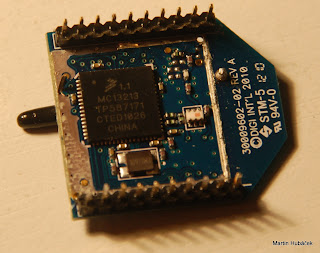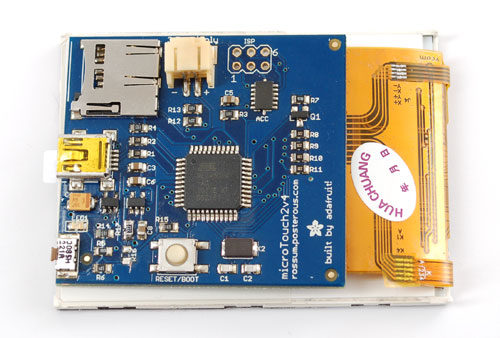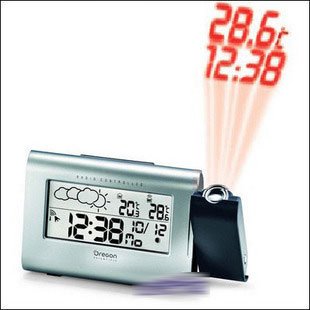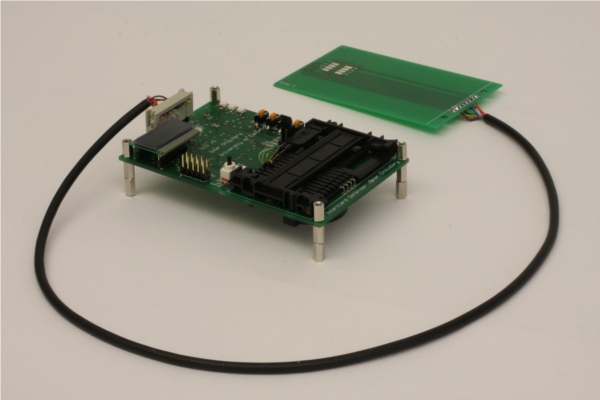You didn't miss anything. I was doing different sort of stuff last months instead of electronics.
Now I'm back in "business". Ordered few LM3S5632 chips and that forced me to create really small layout for this ARM MCU with interesting peripherals:
Saturday, 31 December 2011
Tuesday, 13 September 2011
IR code soundcard software decoder
If you need to analyse IR signals of your infra red remotes and you don't have oscilloscope - try this windows application. You record the signal from your soundcard and the software shows you the waveform, decodes the signal. It supports RC5, SIRP, NEC, Panasonic. Code is open and the app is written in Delphi
http://ostan.cz/IR_protocol_analyzer/
Sunday, 19 June 2011
Store and show your schematics online with CircuitBee
This service allows you to upload (for now only) KiCAD schematics file with libraries and embed them in your site/blog with zooming a panning. The creator of this web said that in the future we would create schematics in his online tool. That's what I'm waiting for years! I would like to have my electronics suite package in the cloud, always latest version and finally with all public libraries shared and instantaneously prepared for use.
http://www.circuitbee.com
Wednesday, 15 June 2011
USB HID rotary encoder
I collected information and code of my older project. You can connect the rotary encoder to the USB and scroll with it in the menus. It's only a proof-of-concept. Take inspiration but don't take the exactly same code :)
http://www.martinhubacek.cz/electronics/usb-rotary-encoder
Interesting PIC constructions by Nicholas Sirirak
but the information on that page is useful also for developers with another platforms. There's something about Xbees, 9bit UART, RTC clock DS1307, Light dimmer.. and a lot of other useful informations and projects.
http://www.pic_examples.byethost3.com/
http://www.pic_examples.byethost3.com/
Tuesday, 14 June 2011
RIGOL and other things
Things are getting to move! I finished my Engineer degree, so now I hope in plenty of free time during holidays.
The RIGOL scope also arrived, so I hooked almost everything to it and studied all possible signals around me :)
Now I'm creating decoder of infrared protocol. I started this project because of need to turn on the HTPC with my infrared remote control. But after the basics I was thinking that maybe I can add support for another protocols, make the PC start impulse programmable, send infrared codes to the computer over UART, handle and program long button press, add support for different crystals and clock speeds.... :)
http://www.martinhubacek.cz/electronics/ir-remote-control-decoder
The RIGOL scope also arrived, so I hooked almost everything to it and studied all possible signals around me :)
Now I'm creating decoder of infrared protocol. I started this project because of need to turn on the HTPC with my infrared remote control. But after the basics I was thinking that maybe I can add support for another protocols, make the PC start impulse programmable, send infrared codes to the computer over UART, handle and program long button press, add support for different crystals and clock speeds.... :)
http://www.martinhubacek.cz/electronics/ir-remote-control-decoder
Monday, 25 April 2011
Interesting tutorials with ENC28J60 and AVRs

Friday, 22 April 2011
Nice USB communiction explanation
I've hit very nice explanation of how USB works. There are many articles but this one is well treated.
I'm also giving out my other favourite site about USB.
Thursday, 21 April 2011
Design your PCB in 3D and find how it fits into the enclosure
I was playing with SketchUp freeware 3D modeller from Google. I wanted to do a simple sketch to visualize some mounting concept with LCD and another board.
Sunday, 17 April 2011
Driverlib for EvalBot !
TI did what they promised half a year ago. They published driver library specially for EvalBot. The sample which made me happy is the sound example - video inside. What the package contains?
Saturday, 16 April 2011
Freescale Race Challenge 2011 Finals in Rožnov
I was in the Rožnov pod Radhoštěm to see how fast are the best autonomous slot cars in Czech and Slovak Republic. I've made some videos so you can see how the cars are speeding up on the straights and braking before corners. It's simple idea to speed up in on the straight but very hard to implement. Sometimes your learning algorithm is "lost" and has to be synchronized by start lane or on the track crossings. The car is acting much different that you were thinking and the only way to figure out what is wrong is to store some telemetry during the ride to the SD card.
My car was almost excellent on short tracks but on bigger track with lot of corners was behaving unpredictably. One change in the code affected another two parameters and the perfect tuning of the PID, learning algoritm, track synchronization, accelerometer/gyro filtering was very hard.
FYI: I was just the visitor, not the racer in the finals. Because I ended in school round somewhere near the end of the table of winners ;)
The entire playlist of my FRC 2011 videos
http://www.youtube.com/view_play_list?p=CA8F11F18AE6A378
The winners' ride:
My car was almost excellent on short tracks but on bigger track with lot of corners was behaving unpredictably. One change in the code affected another two parameters and the perfect tuning of the PID, learning algoritm, track synchronization, accelerometer/gyro filtering was very hard.
FYI: I was just the visitor, not the racer in the finals. Because I ended in school round somewhere near the end of the table of winners ;)
The entire playlist of my FRC 2011 videos
http://www.youtube.com/view_play_list?p=CA8F11F18AE6A378
The winners' ride:
Monday, 4 April 2011
Freescale Race Challenge 2011 - after competetion
OK, my car failed a little :) On the small testing track worked surprisingly well, but on the racing track the car behaved like lost. Few times ended out of track and I lost lot of time with manipulation of switch. Also in the second ride I accidentally pressed the SD card and the card jumped out of the car in the race :)
Monday, 28 March 2011
Freescale Race Challenge 2011
Today is the slot car competition. I had a lot of other things to do so I didn't put much time into preparations. But the car itself can learn track. It has very predictive behaviour and some emergency programs and button in case that something goes wrong. The car can learn track, write it down to the SD card, brake before the corners. Now it's all on the car.. I've made enough :)
Monday, 7 March 2011
Supercapacitor and MSP430
I love this circuit. Unfortunately I haven't supercapacitor so I can't try this at home. This guy connected MSP430 and LCD. This setup worked for four weeks only from capacitors. My MSPs are on the way.. I can't wait to get them :)
Monday, 28 February 2011
Microsoft .NET Gadgteer
Microsoft created an interesting hardware development platform. Every connector, button, display, camera... is a single module and with their combination you create application that you want. You use .NET micro framework with C# as you can expect. Let's see how this platform will be used when it becomes available to public.
What is also interesting is their application that can design a box for your final design with holes for camera, screws etc.
More in the video @ Channel9
http://channel9.msdn.com/Blogs/Clint/NET-Gadgeteer
What is also interesting is their application that can design a box for your final design with holes for camera, screws etc.
More in the video @ Channel9
http://channel9.msdn.com/Blogs/Clint/NET-Gadgeteer
Sunday, 27 February 2011
Destroyed Xbee & what's inside?
I hate when that happens. 3 coincidence events that happened together and made small smoke inside the Xbee. Every time make sure that high voltage (~15V) wires on your breadboard are holding tight. If not, they can rip out, they can randomly move and they can itself connect to wrong hole on breadboard with 3.3V power rail.
Well I cure my angry with even more destroying the Xbee. What's inside? Freescale.. Another hateful coincidence. I hate Freescale chips right now because I'm trying to get them work on Freescale Race Challenge, the slot car competition. They're ... just different.. just not-so-well documented..
Iside the Xbee is MC13213 HS08 microcontroller with capabilities of ZigBee. 40MHz 8bit MCU with 60kB FLASH and 4kB RAM. The maximum power voltage is 3.4V and since I put 15V in this device, sleep well in the sillicon hea.. no.. HELL!
Well I cure my angry with even more destroying the Xbee. What's inside? Freescale.. Another hateful coincidence. I hate Freescale chips right now because I'm trying to get them work on Freescale Race Challenge, the slot car competition. They're ... just different.. just not-so-well documented..
Iside the Xbee is MC13213 HS08 microcontroller with capabilities of ZigBee. 40MHz 8bit MCU with 60kB FLASH and 4kB RAM. The maximum power voltage is 3.4V and since I put 15V in this device, sleep well in the sillicon hea.. no.. HELL!
Friday, 25 February 2011
TI's MPS430 LaunchPad
I was forced by curiosity to try these microcontrollers. Since I'm using mainly AVRs in my projects, I was searching for points where this microcontroller can be better. I just read the datasheet and here are the interesting bits:
- Power consumption - really really small, specialy in deep-sleep modes
- 16bit core.. that's it.. 16×16bit hardware multiplier as peripheral
- nice architecture with 16 16bit registers (12 general purporse registers), orthogonal instruction set
- Vcc and GND pins on the top of PDIP.. easier routing of power wires on the PCBs
- simple DMA controller!
- proprietary 2 wire programming
- bunch of standard peripheral, USARTs, I2C, SPI, PWM, ADC, DAC... depends on chip type
Sunday, 20 February 2011
Ethernet to IR gateway with LM3S6965
Interesting opensource project. This device recieves commands from ethernet and sends them via one of three IR emitters. Sourcecode and hardware design for Eagle is available.
http://code.google.com/p/isendir/
Wednesday, 16 February 2011
Eridani developer board with LM3S3651 ARM Cortex-M3 chip
I like to play with new Cortex M3 developer boards. I use one with LM3S6965 and another with LM3S9B92 which is called Evalbot. This board has also LuminaryMicro/Texas Instruments ARM Cortex M3 chip. The device have preprogrammed bootloader in flash. You don't have to use JTAG. The designer hesitated if he should use the Arduino pin layout - he didn't fortunately :)
Price: $43.00
http://teholabs.com/products/eridani.html
Price: $43.00
http://teholabs.com/products/eridani.html
Sunday, 13 February 2011
Valentine blinking heart
My new project is for Valentine day. Heart shaped traces on PCB, SMD parts and ATtiny2313...
I had some inspiration from other projects and put this together with shelf parts. Battery powered.
http://www.martinhubacek.cz/electronics/valentine-blinking-heart
I had some inspiration from other projects and put this together with shelf parts. Battery powered.
http://www.martinhubacek.cz/electronics/valentine-blinking-heart
Wednesday, 9 February 2011
Electric circuit simulator java applet - analog, digital
I've found very interesting application. This app allows you to simulate analog signals and also digital logic. But what if you don't have to simulate anything? You can watch and learn from examples in the "Circuits" menu item.
Thursday, 3 February 2011
Atmels with touchscreens
Ok, everybody maybe already knows about ladyada's new device called Microtouch.
It's simple device with accelerometer, SD card slot, touchscreen, USB host and li-po charger circuit. It's nice device and I'm looking forward for projects with this device. I like it...
But I want talk about different kit with LCD that I already have and for me is definitely more suitable and maybe could be for you too.
It's simple device with accelerometer, SD card slot, touchscreen, USB host and li-po charger circuit. It's nice device and I'm looking forward for projects with this device. I like it...
But I want talk about different kit with LCD that I already have and for me is definitely more suitable and maybe could be for you too.
Tuesday, 1 February 2011
Reverse engineering digital projective table clock
Today I went shopping and I had to buy this discounted projective clock. Of course not for displaying the time. I never had this type of clock so I followed the first rule of new electronic device: "Don't turn it on, take it apart!" :)
Monday, 31 January 2011
Evalbot I2C & Nunchuk lib
After few long evenings I created I2C library for Evalbot from Texas Instruments. I wanted use I2C module which can be connected to J0 and PJ1 pins which are perfectly accessible but I had no luck with initialization of them.
So the second try was about using another I2C module connected to pins PB2 and PB3. These pins are also on expansion connector but I don't have the other side of the connector so I soldered near the pull-up resistors and the audio codec.
Short tutorial, pictures and libraries are on the homepage
Sunday, 30 January 2011
ARM Webradio
Internet radios are great. There are so many stations, some are even without commercials and speaking.. just music. I was playing with idea to create webradio because there's not much devices of this kind on the market. My approach is different and I'm trying to implement software based Helix MP3 decoder... but with no luck so far..
Fortunately there are more skilled people than me and created perfect designs... What I don't like is that you have to use VS1053 decoder chip because ARM CortexM3 running even @ 30MHz is powerful enough to do software decoding. I hope that sooner someone do the design without external hardware decoder.
ARM webradio project @ Google Code
Small USB AVR programmer using USBasp
A year ago I created a new layout for USBasp programmer because I wanted really small sized device. I have changed pakage of some resistors and capacitors to SMD, so the parts could stick better together and use smaller area on PCB. I don't know how but I was lucky to fit it all inside small Tic-Tac mint box.
The whole project and files are here
Slot car finally completed ... somehow
Tonight I was fighting with prepared board from Freescale for slot car competition (Freescale Race Challenge). This year is the car smaller, but board remains the same, so I had to use some force and hot glue gun to put all in the place :) After some hardware issues I was able to flash the sample application over USB mass storage bootloader.
Now I have to learn all about Coldfire MCF51JM128RM because I'm not familiar with them. Also I have to play with accelerometer, it's sensitivity and filter algorithms.
I'm planning some hardware modifications, optical encoders...
Saturday, 29 January 2011
Evalbot I2CS1
Finally I have some time to play with Evalbot. But now I'm having difficulties with I2C. For the easier acces you can map the I2CS1 (the second one I2C module) to PJ0 and PJ1 pins. They are accesibley with standard breadboard-like pich, much easier than solder wires to small resisotors near Audio chip if you don't have the small connector for expansion board... When I do some progress, I'll make a post about it.
Friday, 28 January 2011
Freescale Race Challenge
I'm attending the Freescale Race Challenge this year. The goal is to create an autonomic driven slot car. You can use your hardware inside the car or use the PCB from Freescale and tune it to your needs. It contains Coldfire MCU, microSD card slot, driver for motor and accelerometer. This platform is new to me. But I would like to play with their architecture.
I add some sensors and buttons to the design and start developing. The school contest round is in March so there's not much time.
Here I found some english text about this contest.
Tuesday, 25 January 2011
Simple hello world by LED for LM3S9B92 and LM3S6965
You can download sample project for this chips and/or development boards. Makefile is for Codesourcery G++ compiler. The sample is using Systick interrupt.
http://www.martinhubacek.cz/electronics/luminarymicro-evalbot
http://www.martinhubacek.cz/electronics/luminarymicro-evalbot
LuminaryMicro Evalbot kit arrived!
I was surprised, when this package arrived. I didn't expected what it could be. When I opened it I was really happy. This Evalbot cost me only $25 instead of full price $150 :) So it took 3 months from order to delivery. I'll take a look on the kit later because of exams in school.
I already have one kit from LuminaryMicro - LM3S6965. But not on wheels :) This new kit has also USB on-the-go support and small I2S audio codec. I was developing a MP3 internet radio player with older kit, but now it looks like all I need to do is wait until someone do MP3 player for me on this new kit :)
In few days I'll post how to configure arm-none-eabi compiler for this Evalbot and older LM3s6965 kit. I was using IAR compiler but I think that opensource GCC is better for opensource projects.
Monday, 24 January 2011
Simple DC/DC step-down module
Today I designed and made step-down converter with pins like the 78xx stabilizers have. So it's perfect for breadboard design or replacement for 78xx stabilizer. Unfortunatelly it's using small SMD inductor so it cannot give you more than about 350mA. But it can handle the input voltage to 40V and don't get too hot like linear stabilizers. So no need for cooling :) You can use online calculator to change output voltage or change values of parts so you can get higher current.
Go to the article
Saturday, 22 January 2011
MOS 6502
If you want to know more about this special processor that powers event bender, look at video below. Michael Steil had a very interesting presentation about it. He's quite fast in the begining of presentation but he explained everything from complete basics to mechanical reverse engeneering of the chip.
Bunch of electronic parts
I finally have what I ordered :) Connectors and a lot of SMD parts. Some for my thesis or another projects. I've ordered some capacitors in SMD 0603. They are so small that my tweezers almost cannot pick them :)
There's image from wikipedia for comparison.
I also ordered 3pin conectors with a key on them so it's not possible to connect the plug incorrectly. I was always nightmare to figure out in what direction I have to insert digital thermometer DS18B20 because if you do it wrong, you destroy it :) I hope in brighter tommorrows without that old pinheads.
There's image from wikipedia for comparison.
I also ordered 3pin conectors with a key on them so it's not possible to connect the plug incorrectly. I was always nightmare to figure out in what direction I have to insert digital thermometer DS18B20 because if you do it wrong, you destroy it :) I hope in brighter tommorrows without that old pinheads.
Friday, 21 January 2011
Cool minicomputer
I've found an interesting czech project. Ok it's another wrist-watch like computer :) But this one has bluetooth connectivity and runs almost completely on Lua scripting language. On the video it seems quite fast but there's not any information about hardware. That's sad. The sourcecode is opened but the hardware looks like "closed-source".. maybe later..
Hackerspaces around
Thursday, 20 January 2011
Step-down DC/DC converter: Say goodbye to 78xx linear stabilizers
For last couple of months I've been playing with DC/DC converters. Mainly step-down converters. I really like them. I had a linear stabilizer in my circuit and the device's consumption was 1,2W. When I changed my design to use DC/DC step-down converter - the consumption was 400mW - 3 times lower! I'm actually designing small modules with usual MC34063 chips. In standard PDIP version and SMD. I've ordered them very cheaply on eBay from China instead of expensive order here in Czech Republic :)
Dave Jones on his videoblog have very nice lessons on how to start with DC/DC converters. Maybe it's time to give a peace and cool place for that old and heating 78xx linear stabilizers, what do you think? :)
Dave Jones on his videoblog have very nice lessons on how to start with DC/DC converters. Maybe it's time to give a peace and cool place for that old and heating 78xx linear stabilizers, what do you think? :)
Wednesday, 19 January 2011
Free book of Digital signal processing
For anone interested in DSP there's a free online book. I'm still waiting for the right moment (or free time) to start read it. The book is online but you can download each chapter in PDF.
Chip and pin security on bank cards is broken
I like a lot attempts to hack consumer devices. This bank card trick is something more than that but still very interesting. Student from Oxford created a device that stands between real bank card and paying terminal. With this device you simply don't have to enter pin. Just write something like four zeros and the transaction will work..
Omar's thesis and info is on his site.
Also there's a video from congress about this topic.
Let's start here
Hi everyone. Last days I was thinking that it would be nice if I can tell something valuable to other people. People that are interested too in electronics, programming, microcontrollers, opensource software etc..
We'll see how far this will go :)
We'll see how far this will go :)
Subscribe to:
Posts (Atom)






























